If You Work on a Laptop, You Should Really Invest in a Wireless Keyboard

"Hearst Magazines and Yahoo may earn commission or revenue on some items through these links."
Everybody needs a good keyboard–it's as simple as that. Whether you’re responding to endless office emails, writing a novel, playing video games, or whatever else, most of us spend a lot of time typing at work and at home. The keyboard you choose plays a bigger role than you may think in making those experiences positive.
Many people treat keyboards as dumb, interchangeable tools, but there's a lot of nuance to their design. In some cases, getting the right keyboard means making sure you have all the keys you need–If you're on a Mac, you don’t need a Windows “Start” key. But beyond that, there are keyboards designed for comfort and keyboards designed for efficiency. There are gaming keyboards and keyboards that can help make you more productive. No matter what they’re doing, no matter where they’re doing it, the best wireless keyboards can improve the typing experience for your friends and loved ones.
More Tech Gift Recs: The 100 Coolest Gadgets of 2024 ● Best Small TVs ● Best Wireless Earbuds
The Best Buying Guides
Best Overall: Razer Pro Type Ultra Wireless Mechanical Keyboard
Best Value: Cherry Stream Wireless Keyboard
Best for the Office: Logitech MX Keys S Wireless Keyboard
Best for Mac: Apple Magic Keyboard with Touch ID and Numeric Keypad
Best for Gaming: SteelSeries Apex Pro Mini Wireless Keyboard
Best Ergonomic: Logitech K860 Wireless Split Keyboard
Best for Tablets & Phones: Logitech K780 Wireless Keyboard
Best Wireless Mechanical: NuPhy Halo65 Wireless Mechanical Keyboard
The Expert: I’ve written news, reviews, and explainers for a variety of tech and gaming publications, including TechnoBuffalo, The Tech Report, GameSpot, IGN, covering a variety of computing- and gaming-related topics for over 15 years. I’ve reviewed and written reviews on more than my fair share of keyboards. Plus, as a PC enthusiast since childhood, I'm always trying new gear while playing games, working, and tinkering with my PC.
What to Consider in a Wireless Keyboard
When you decide to dump the keyboard that came in the box with your computer, the search can seem intimidating at first. There are hundreds of relatively new keyboards out there, so it's easy to quickly find yourself drowning in a sea of options. Don't worry, though. There's a keyboard out there for everyone–whether you’re shopping for yourself or helping someone you know make an upgrade.
Connectivity: Bluetooth, 2.4 GHz Wireless, and… Wired!?
If you’re cutting the cord and going with a wireless keyboard, you’ll want to take a closer look at how your keyboard connects to computers and other devices. Most wireless keyboards connect via Bluetooth, which can connect to pretty much any PC or mobile device, and doesn't require a dedicated USB dongle. Bluetooth connectivity has come a long way in the last decade, but it still isn’t entirely stable. It isn’t unheard of to lose connection for a minute, or for your computer to just forget the device entirely, seemingly without reason. It doesn’t happen often and is almost always easy to fix, though.
That said, there is a better option: Many high-end keyboards support a 2.4 GHz wireless connection via USB or USB-C dongle, which you plug into your device. These connections tend to be more stable, and cut out the small amount of input latency you get from Bluetooth. This is probably overkill for an office keyboard, but it’s a nice benefit for gaming keyboards and any activity where a little lag between your fingers and your PC may cause trouble.
Then there’s the wired option. This is a wireless keyboard list, right? So why are we even talking about wired keyboards? Many premium wireless keyboards also allow you to plug in and use them as wired keyboards, which lets you keep working while their batteries charge. Given that, keep in mind whether your laptop has the right ports and cables to connect with your computer–we’re looking at you Macbook Air users.
Battery Life
Wireless keyboard battery life isn't the issue it was five years ago, especially if you’re willing to forgo flashy RGB backlighting. If your wireless keyboard has backlighting, you can typically expect 10- to 20 hours of battery life from the keyboard with the lights on at full brightness. Most keyboards will last significantly longer if you turn your backlighting off, with many manufacturers offering estimates measured in months or years, rather than hours.
Most high-end wireless keyboards use built-in Lithium-ion batteries, which need to be recharged regularly, but let you charge and type at the same time. Other keyboards, especially budget models, often rely on disposable AA or AAA batteries, which often get amazing battery life in exchange for other tradeoffs. For example, the Logitech K860 can last up to two years on a pair of AAA batteries. On the other hand, if you don’t have replacement batteries on hand, dead batteries mean a dead device. And disposable batteries introduce e-waste, which is bad for the environment.
Keyboard Size
One of the first and most meaningful differences you’ll notice in a keyboard is its size. They come in a surprisingly large range of options, with different amounts of keys so you can strike a balance between the convenience of having more keys, and the minimalist pleasure of a more compact design that saves desktop real estate.
The largest option, a “full-size” keyboard, is what you’ll probably find at your office: It has 104 keys–that’s everything you can think of, plus the number pad on the right side. From there, the options get smaller. A tenkeyless or “TKL,” which looks identical to the full size but drops the number pad, has around 87 keys.
The smallest common model is the “60 percent” keyboard, which is named for the fact that it has 60 percent as many keys as a full-size model. With just 61 keys, it drops the number pad, arrows, editing keys, and function keys, leaving you with just the core grouping of alphanumeric characters and punctuation.
From there, you can find a wide range of in-between form factors. Some wired full-size gaming keyboards, like the Corsair K55 RGB, have extra keys so you can create custom functions without giving up any functionality. Apple’s Magic keyboard with Touch ID is compact, but features a surprisingly robust 78 keys. If you want to learn more about the nuances of keyboard sizes, there are some great in-depth guides around the web, like this one from HirosArts.
Switches
Every key on a keyboard has a “key switch” underneath, which serves as the mechanism that sends a signal to your computer when you press down on it. In addition to making the keyboard work, switches dictate how it feels to push down on the keys. The press can be short or long, it can require more or less force, and it can give feedback, like a clacking noise or tactile “bump” sensation when the switch activates. Enthusiasts treasure mechanical keyboards because they offer the most room for nuance and customization, though there are many options that may make sense for you or your giftee.
There are a bunch of different types of switches, and this is primarily a matter of personal preference. Here are the basics:
Rubber Dome: Cheap keyboards, especially the kind that come with a new PC, feature rubber dome switches, which were the dominant type of key switch for a long time throughout the 1990s and early 2000s. Each key has a rubber dome underneath, which bounces the top of the key back up after you press it. Keyboard enthusiasts complain that they feel mushy and uncomfortable. That said, they’re inexpensive and more spill-resistant than other options.
Mechanical: Keyboard enthusiasts prefer mechanical keyboards, which offer reliability, endurance, and lots of room for customization. Each key features a physical switch that you activate to send a signal from the keyboard to your computer. These switches come in a variety of styles that allow you to refine and, in many cases, customize how it feels to press the keys down. One thing to keep in mind: Mechanical keyboards tend to make more noise than other keyboards, and some might be too loud for an office setting.
Scissor: Used in laptops and extremely thin models like the Apple Magic Keyboard, scissor switches are, above all, compact. They’re sturdy and reliable, but offer little room for fingers to press down, or “travel,” making them less comfortable to type on than larger models. (They’re also tough to clean thoroughly if you like to keep a tidy desk.)
Windows vs. Mac
Most keyboards can connect to any Windows or macOS computer without any additional software, but some keyboards are made for Windows or Mac, specifically, and will feature slightly different layouts. Windows is the default for most brands, so it’s on Mac users to seek out a Mac-specific keyboard if they want an “Apple” key rather than a Windows “start” key.
Additionally, many keyboards support an optional configuration app, which allows you to remap keys, save custom shortcuts and customize other features. You should always check a keyboard to see whether its software supports your OS: While you don’t need to download this software to use your keyboard, it seems wasteful to pick up a keyboard if you won’t be able to use all of its features.
Keep in mind that some advanced features will not work when you connect to mobile devices like smartphones and tablets.
How We Selected The Best Wireless Keyboards
To select the best wireless keyboards based on my own personal keyboard testing for work and play, as well as research for past projects and dedicated reviews from a number of tech critics at publications like RTINGS, Tom’s Hardware, and PC Magazine. Of course, I also checked user reviews from threads on Reddit boards like r/MechanicalKeyboards and r/Keyboard, to make sure that everyday users also liked them.
Pro Type Ultra Wireless Mechanical Keyboard
The Razer Pro Type Ultra is a mechanical keyboard you can feel good about using at the office. This full-size keyboard features Razer “silent” yellow linear switches, which have a smooth, silent actuation with no bump or click. They make very little noise, so you won't annoy your coworkers with loud clacking.
It also features a full suite of connection options, including 2.4 GHz Wireless, Bluetooth and a wired mode. Using all of its connection options, you can pair to as many as four devices at once, so you can connect and switch among your desktop, laptop, tablet and phone quickly and easily.
Throw in some nice bells and whistles, including a wrist rest, media keys, and optional backlighting, and you have a pricey, but versatile keyboard that you can feel good about using for any task, in any setting.
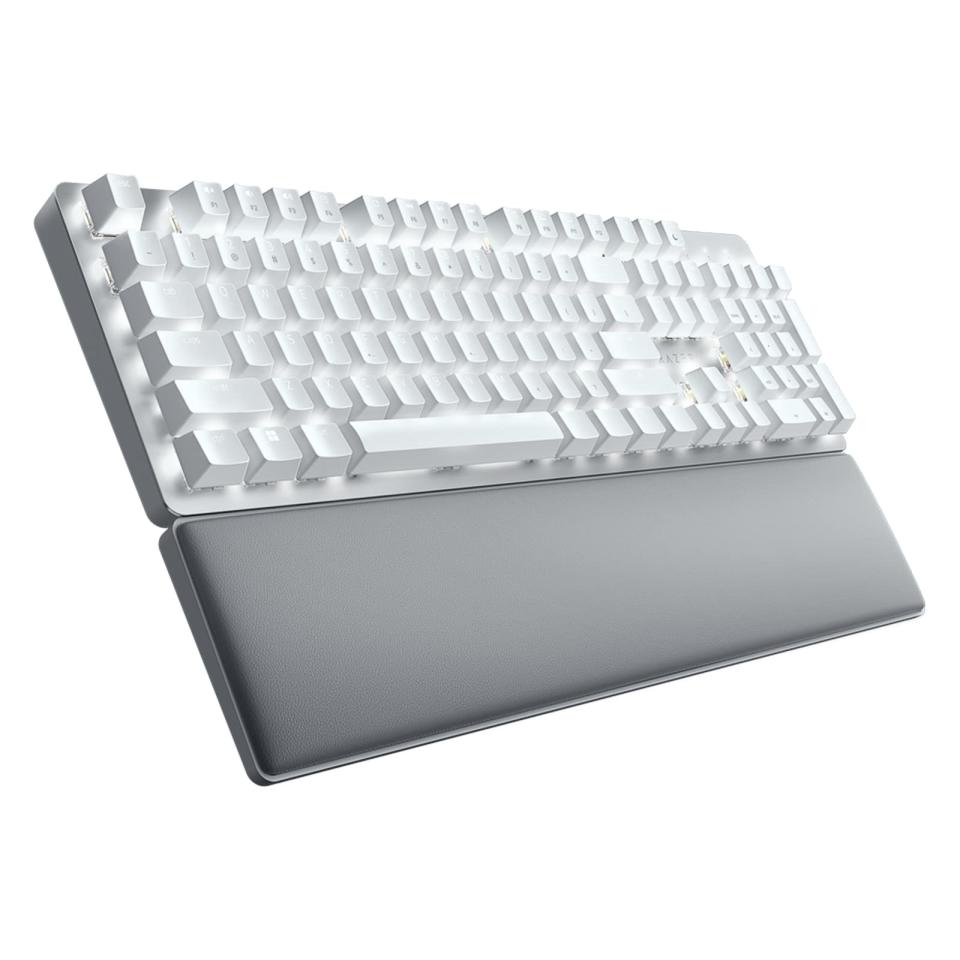
Pro Type Ultra Wireless Mechanical Keyboard
amazon.com
$159.99
Stream Wireless Keyboard
You don’t need to spend a lot of money to get a better-than-average wireless keyboard. In recent years, a crop of budget-tier mechanical keyboards from reputable brands has lowered the threshold for getting a solid keyboard. Made by mechanical key switch maker Cherry, the Stream’s low-profile scissor switches feel stable and pleasant under your fingers.
The software, which allows you to remap the Function and Media keys along the top of the keyboard, is sadly Windows-only. Since it’s really just for changing those keys, it isn’t a huge loss for Mac users, though.
Powered by AA batteries, which we normally avoid to minimize e-waste, but Cherry claims the Stream will last for three years on a single pair, so you may only need to replace the batteries 2-3 times. And if you have a batch of rechargeable batteries at home, that's even better.
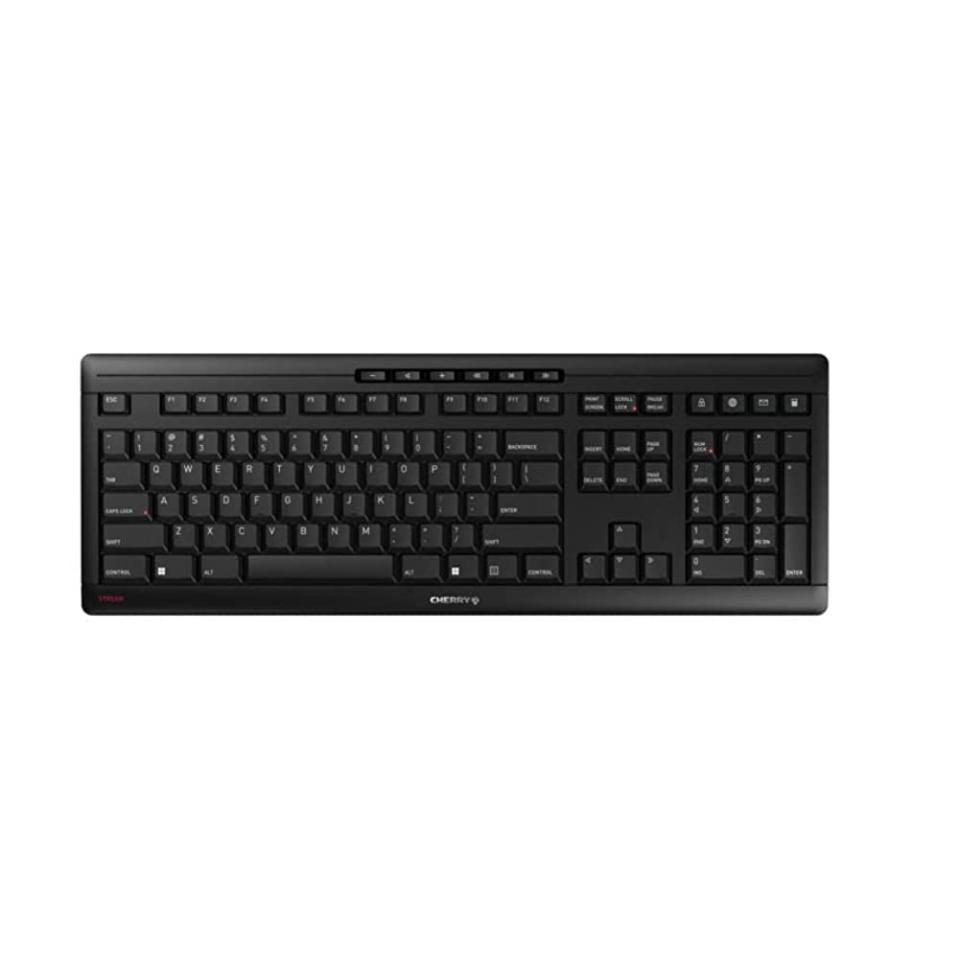
Stream Wireless Keyboard
amazon.com
$45.26
MX Keys S Wireless Keyboard
Made for the office, the Logitech MX Keys S feels like the best version of the average office keyboard. It eschews flashy features like media keys in favor of an efficient, subtly elegant design. Its low-profile keys feature concave caps, which Logitech claims will help you find keys and minimize typos. (Sadly, you're still responsible for your spelling errors, though.) You lose the extended travel of a mechanical keyboard, but it’s absolutely silent without fully sacrificing comfort.
That said it has its own sense of flair, with dynamic backlighting that turns on when you approach the keyboard, and adjusts its brightness based on the light in the room. Whether you turn the lighting on or keep it off, it gets tremendous battery life–from 10-150 days on a single charge.
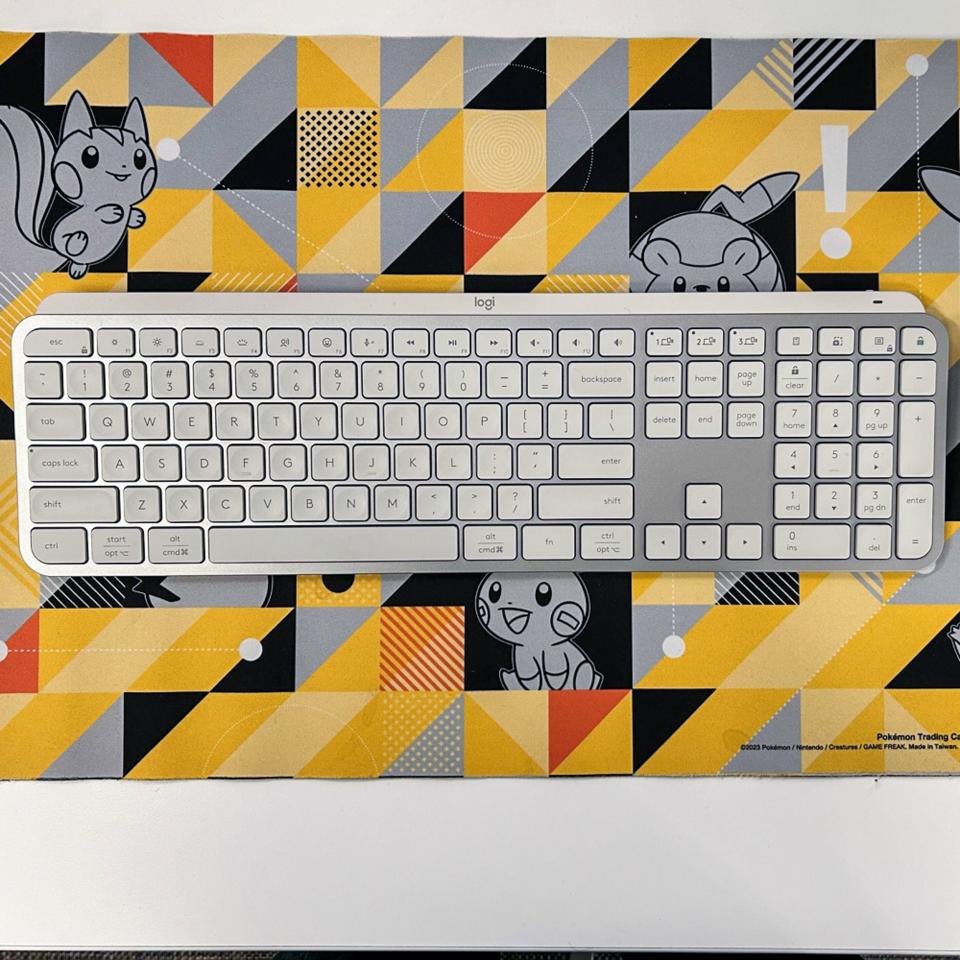
MX Keys S Wireless Keyboard
amazon.com
$109.99
Mike EpsteinMagic Keyboard with Touch ID and Numpad
There are just some things you can’t get from a third-party Mac keyboard. Sure, there are great mac-friendly gaming and mechanical options out there, including a few Apple-specific layouts, but you won’t find seamless Mac pairing or a Touch ID fingerprint sensor on anything other than Apple’s Magic Keyboard.
Luckily, the Magic keyboard is much easier to recommend than the Apple Magic Mouse and its notorious charging port. It perfectly recreates the experience of typing on a Macbook, while delivering strong month-long battery life with normal use. I recommend going for the larger full-size version, rather than the smaller classic design, because you get all the keys you need for any situation. If classic Apple simplicity is your goal, accept no substitutes.
One thing to keep in mind: The current version of the Magic Keyboard is only compatible with Apple’s last few generations of computers, starting with the 2020 “M1” machines. If you have an older Mac, you can still get the older Magic keyboard without the Touch ID key.
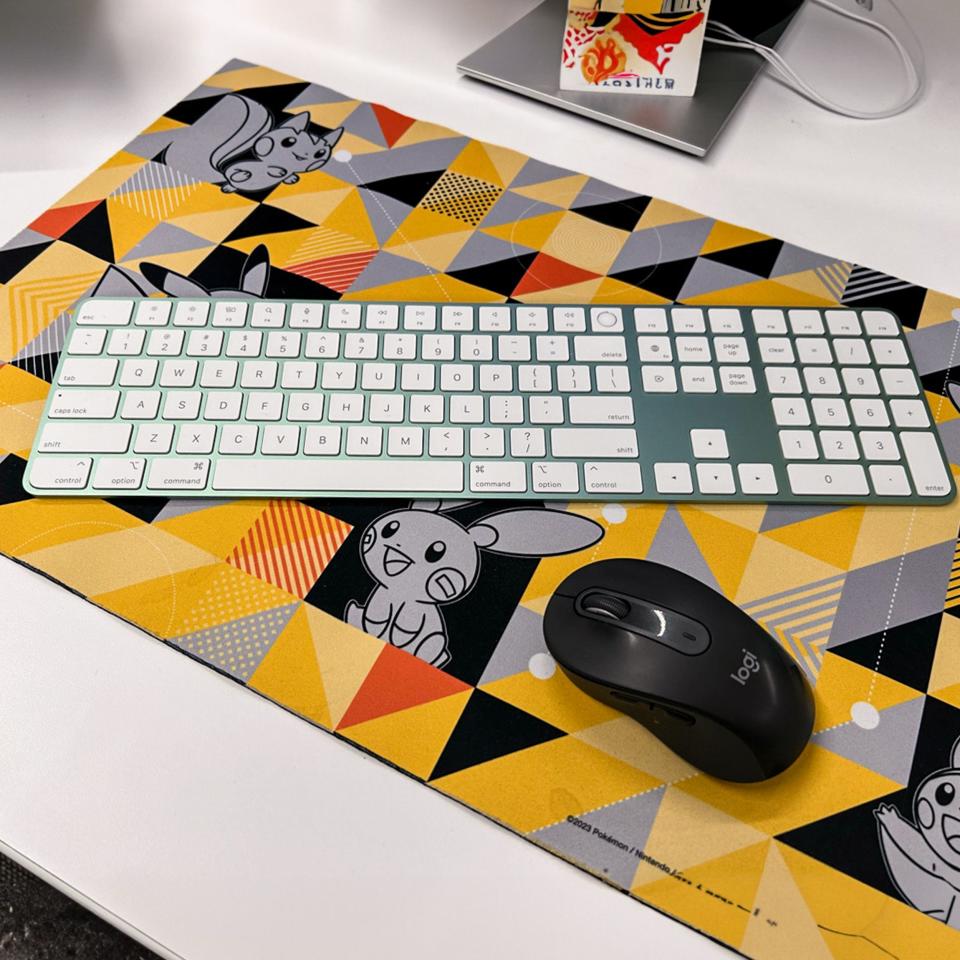
Magic Keyboard with Touch ID and Numpad
amazon.com
$179.00
Mike EpsteinApex Pro Mini Wireless Keyboard
The SteelSeries Apex Pro Mini Wireless is the kind of keyboard you want when you spend more time playing games on your PC than typing. Its compact form factor dispenses with many of the keys you’ll find on a full-size, including the function row, arrows and editing keys, which makes it easy to position on your desk.
The secret sauce in the Apex Pro, however, is in its magnetic “Hall effect” switches, which allow you to adjust each key’s resistance and actuation point, or where the key “detects” that you’re pressing it. This allows you to adjust how the keyboard feels and/or optimize for high-performance. You can even set two actions to a single key, which will activate at different points as you push it down. For example, you could set the W key to "walk" when you press it lightly and "sprint" when you press it hard. It’s hard to wrap your head around, but it can be a really neat gaming-focused feature when used well.
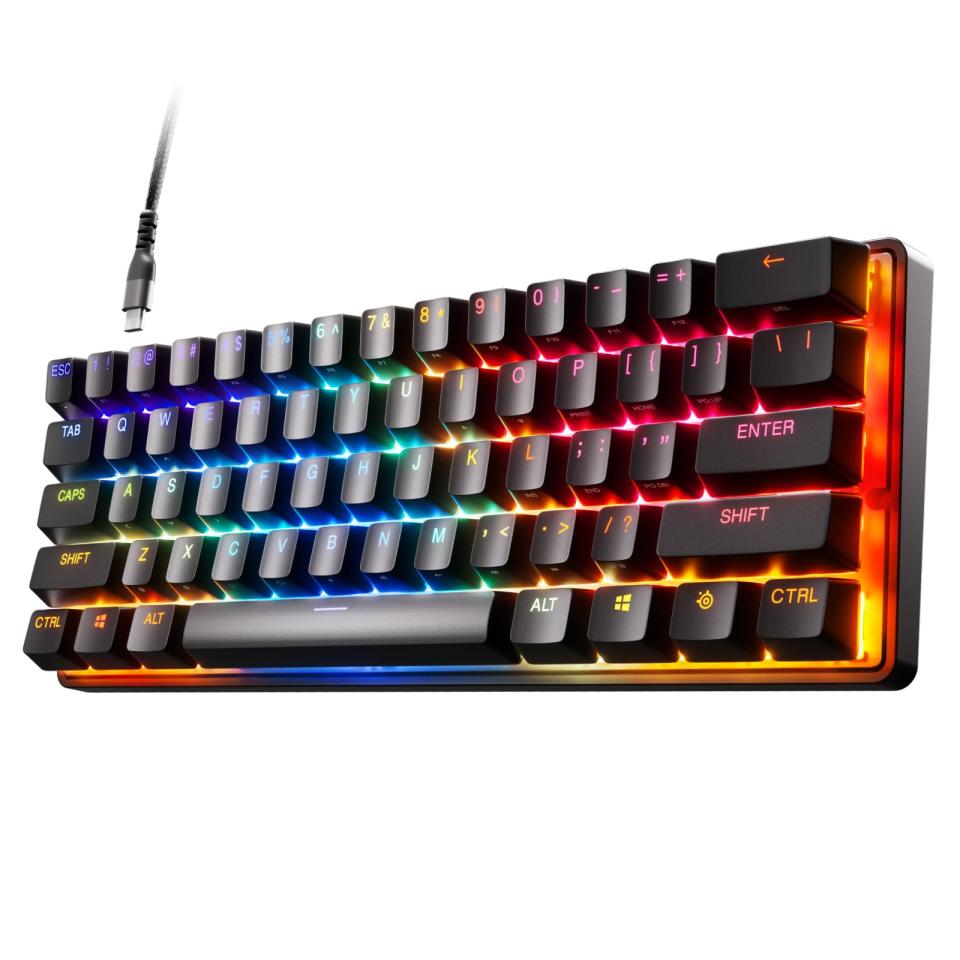
Apex Pro Mini Wireless Keyboard
amazon.com
$139.99
K860 Wireless Split Keyboard
If you have started to feel pain in your hands, wrists or shoulders when you type, it may be time to switch to an ergonomic keyboard. There are a range of health-minded alternative keyboard designs made to minimize the long-term strain of using a keyboard all day, every day by minimizing the number of stretching and twisting motions you make while typing.
If you aren’t sure if you want to switch to an ergonomic keyboard, or simply want to dip your toe in the water, I recommend Logitech’s K860 Wireless as an approachable and effective starter option. This arc-shaped full-size keyboard features a split ergonomic layout that lets you rest your hands and wrists at angles less likely to reduce wrist twisting. All ergonomic keyboards take some time to get used to when you start using them because of their shape and layout, but the K860 is easier to pick up than most.
It also has strong productivity focused features, like the ability to connect to up to three devices via 2.4GHz and Bluetooth. Its low-profile switches give it a slim look and laptop-esque typing feel. The board runs on two AAA batteries, and Logitech promises about two years on those two little batteries alone. There are ergonomic keyboards with more customization and support options, but the K860 makes it easy to take the leap and embrace a more ergonomic way of typing.
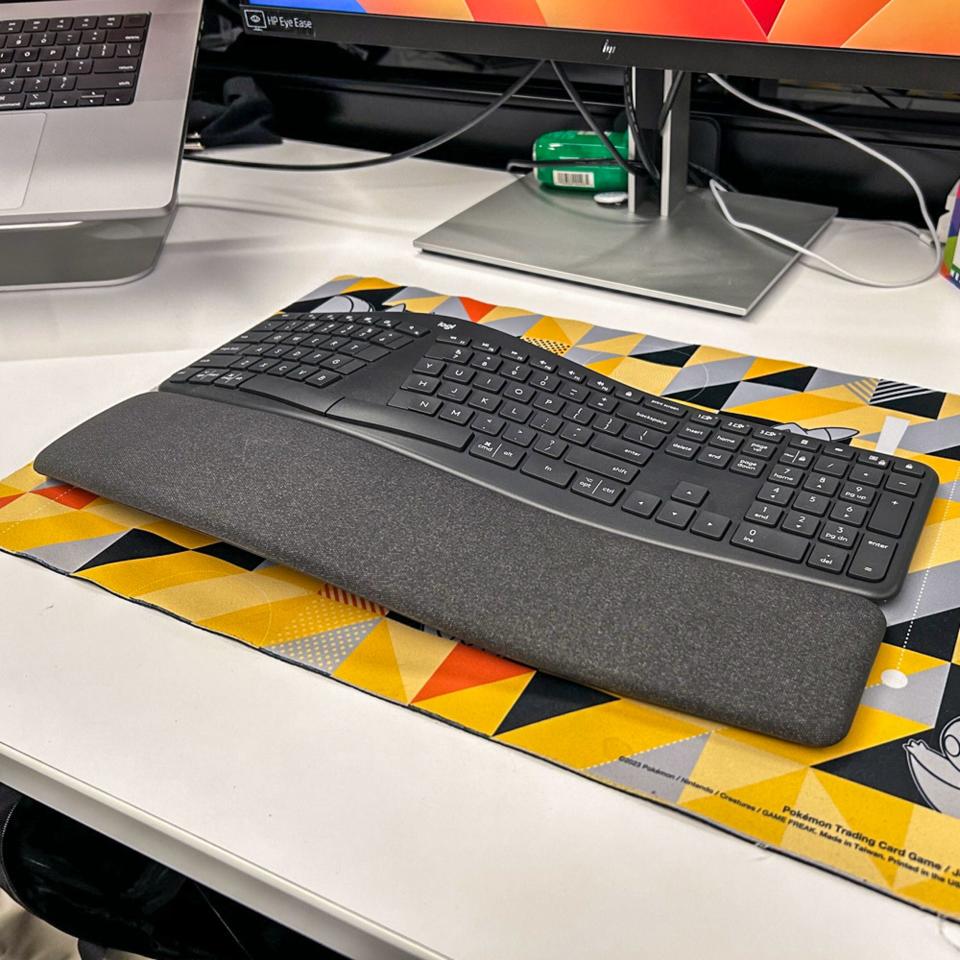
K860 Wireless Split Keyboard
amazon.com
$129.99
Mike EpsteinK780 Wireless Keyboard
If you type out long emails or do work on mobile devices regularly, you know that sometimes your phone or tablet’s digital keyboard doesn’t cut it. Between constantly tapping on glass, tangling with imperfect autocorrect solutions, and propping up your device while you write, there’s a point where it makes sense to break out a travel-size keyboard and get typing.
The Logitech K780 is a perfect solution for mobile typists. It's a fully functional desktop keyboard, complete with a number pad, that will easily fit in a backpack, pairs easily with mobile devices and even includes a stand to keep them stable. It's a little on the heavy side at nearly 2 lbs, but that ensures that it'll stay four-on-the-desk for the vast majority of mobile devices. If you're going to write a screenplay on your phone or monitor Twitch chat with a tablet, this is an excellent option.
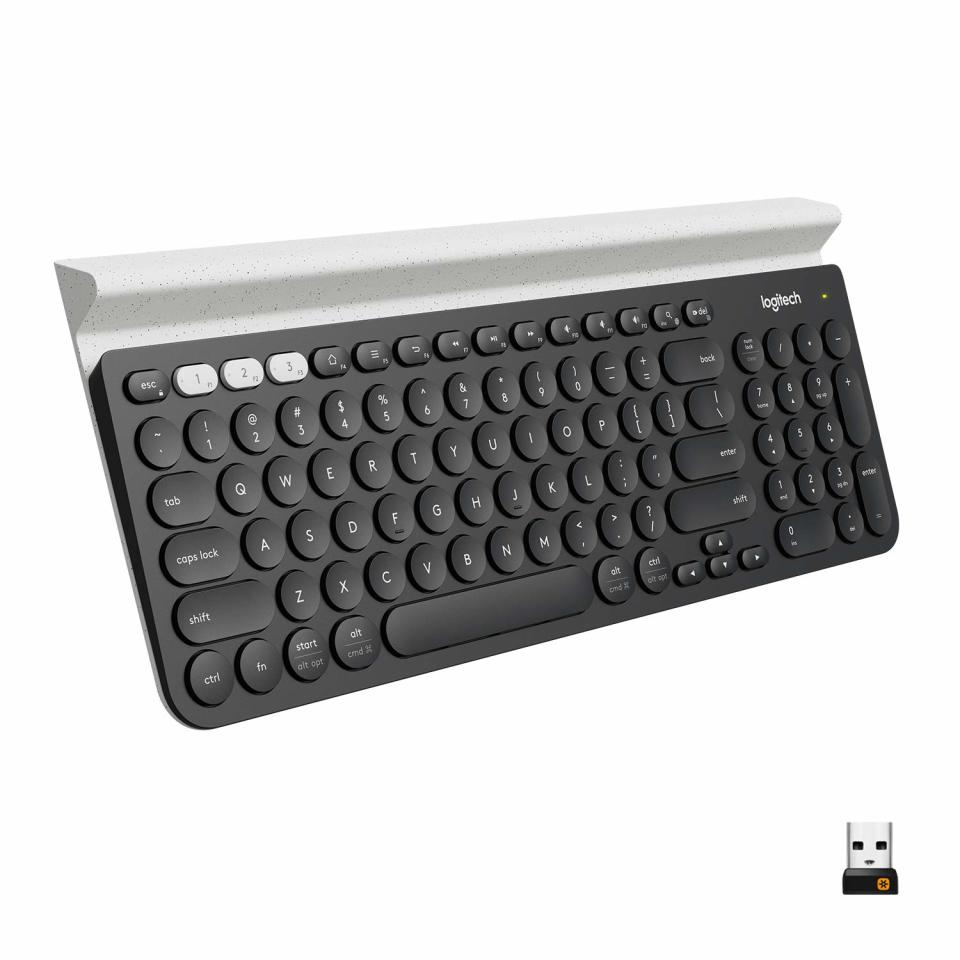
K780 Wireless Keyboard
amazon.com
$59.99
Halo65 Wireless Mechanical Keyboard
For an introduction to the enthusiast-grade mechanical keyboard experience, I suggest trying out the NuPhy Halo65. Its 65 percent layout stops just short of the full compact experience, saving the arrows and editing keys.
The Halo65 is also more customizable than most keyboards from major brands, it’s available in two colors, with 6 switch options out of the box. More importantly, you can remove your switches and replace them with another set whenever you want. It’s got strong connectivity credentials, with 2.4 GHz, Bluetooth, and wired modes.
It's a good looking keyboard that doesn't skimp on the important part--typing--and stays light on extraneous features that can hog battery life or make a keyboard more complex to use.
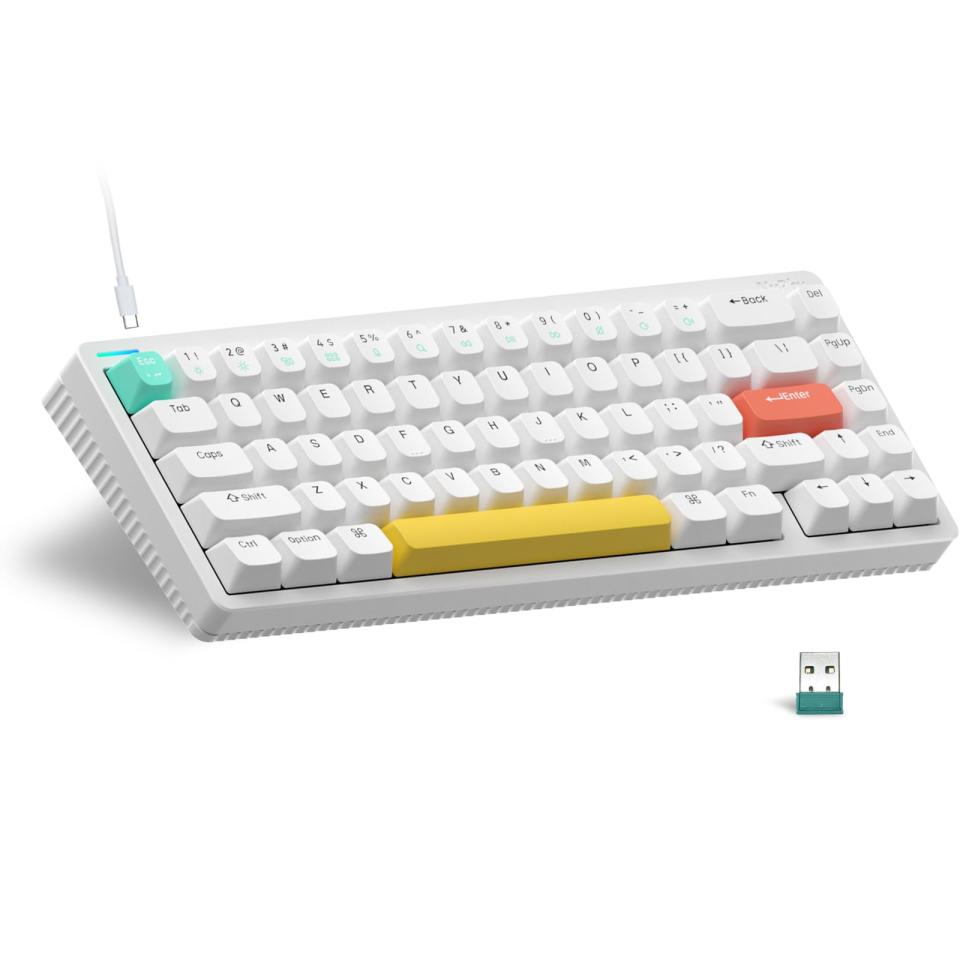
Halo65 Wireless Mechanical Keyboard
amazon.com
$139.99
Q+A With Our Experts
Is a wireless keyboard good for gaming?
Absolutely. When manufacturers started making wireless keyboards and mice, input lag could have a meaningful impact on how it felt to play PC games. That was more than 10 years ago, though.
Modern wireless keyboards introduce far less input lag than those early models. Bluetooth can still sometimes feel off, especially in public places with lots of wireless signals. As a result, most premium wireless gaming keyboards (and many high-end productivity keyboards) provide a 2.4GHz wireless connection to ensure the best possible experience. Wired will always technically be the “best” choice, but the difference should be imperceptible for most players.
What keyboard layout should I get?
As we explained above, keyboards come in a wide array of form factors. Picking the “right” one is largely a matter of personal preference and taste, but there are certain scenarios when some are better than others.
For example, if you're using your keyboard exclusively for gaming, you might be able to get away with a 60 percent keyboard that drops everything except the core keys. If you're crunching a lot of data or filling out spreadsheets, on the other hand, you may find yourself in need of a number pad, which means using a full-size keyboard. Look at the keyboard you have right now and think about how often you use each "block" of keys on the keyboard, and that will give you a good idea.
If you still want the smaller keyboard but sometimes have to do some number crunching, you could also buy a separate number pad to break out when you need it.
Should I turn off my keyboard’s backlight?
Backlighting can substantially reduce the battery life of your wireless keyboard, so there’s a very reasonable argument that you should keep it off at all times. If you work in the dark or have trouble seeing the printing on your keyboard's keys, though, it may make a tangible difference to your workflow. Bottom line, it really comes down to charging time. If you turn your backlight on, you’ll likely need to charge your keyboard every week or so. If that’s a problem, make sure to turn the lighting all the way down in your settings.

You Might Also Like

